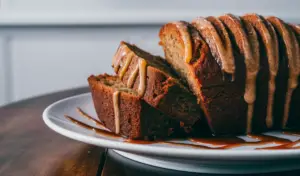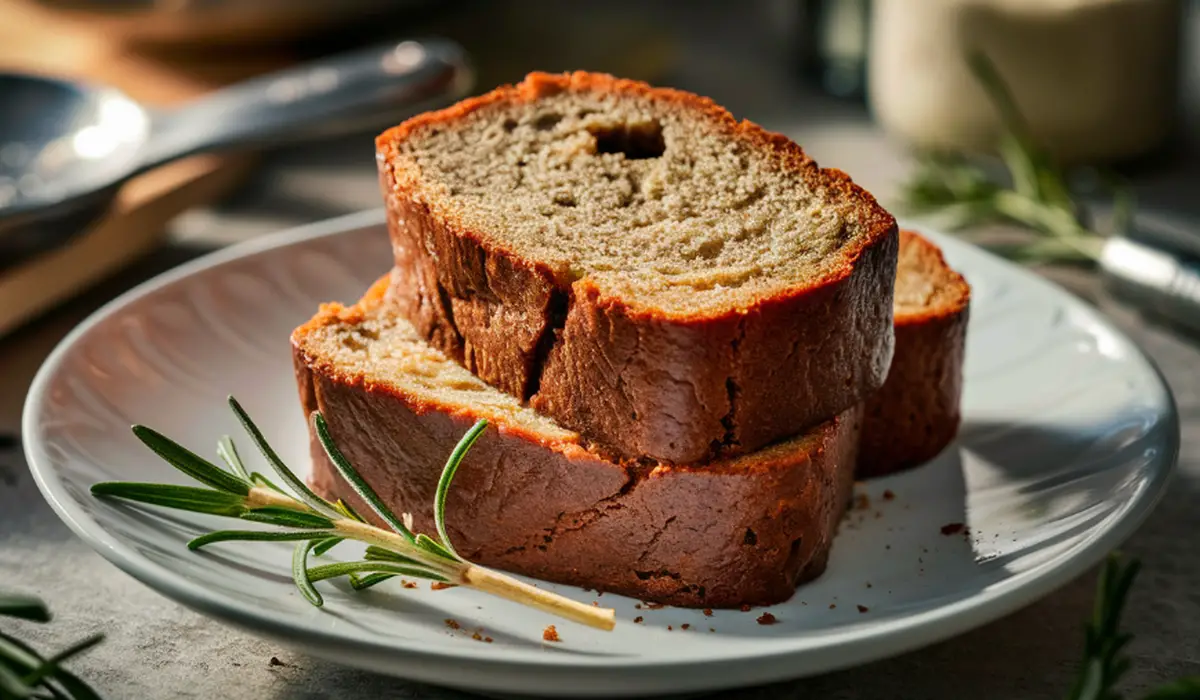Banana bread is one of those timeless recipes that almost everyone loves. It’s simple, comforting, and a great way to use up overripe bananas that might otherwise be tossed. But what happens if, in the flurry of baking, you accidentally forget the baking soda? You may have noticed a difference in the texture, flavor, and appearance of your bread, but what exactly is going on? Let’s dive deeper into the science behind banana bread, the role of baking soda, and what to expect if you leave it out.
The Role of Baking Soda in Baking Soda in Banana Bread
Before we discuss the consequences of omitting baking soda, it’s essential to understand what baking soda does in the baking process. Baking soda, also known as sodium bicarbonate, is a chemical leavening agent. When combined with an acidic ingredient and exposed to heat, it produces carbon dioxide gas, which helps baked goods rise.
In banana bread, baking soda works by reacting with the acids in ingredients like overripe bananas, yogurt, or buttermilk to create bubbles. These bubbles expand when heated, resulting in a light, fluffy texture. Without baking soda, the bread will not have the same lift and might be denser.
The Chemical Reaction Explained
Baking soda requires an acidic component to activate. When it does, it creates the carbon dioxide bubbles that become trapped in the batter, allowing the bread to rise. This is why recipes often call for an acid like buttermilk, yogurt, or even vinegar when using baking soda. The acid and the sodium bicarbonate neutralize each other in the process, resulting in a balanced, tender crumb.
If you leave out baking soda, you miss out on this essential reaction, and your bread won’t rise as expected.
What Happens When You Forget Baking Soda in Banana Bread ?
When you forget baking soda in banana bread, several things can happen. The most noticeable effect will be on the texture. Here’s a breakdown of the changes:
1. Texture: Denser and Heavier Baking Soda in Banana Bread
Without baking soda, the banana bread will not rise properly, which results in a denser texture. This can make the bread feel heavier and less airy. Instead of a fluffy, cake-like consistency, you’ll end up with a much denser loaf, almost like a banana pound cake.
2. Color: Less Brown Crust
Baking soda also plays a role in browning. When the bread rises and the outer surface is exposed to heat, baking soda helps with caramelization and browning. Without it, the loaf may be paler than usual, lacking the golden-brown color that makes banana bread so visually appealing.
3. Flavor: Altered Taste
Although baking soda is primarily used for leavening, it also affects the flavor. Its alkalinity neutralizes some of the acidity in the batter, which can otherwise lead to a slightly tangy taste. When omitted, you may notice that the bread has a slightly more acidic flavor or, conversely, tastes blander due to a lack of balance in the recipe.
4. Moisture: Slightly Denser but Not Dry
Surprisingly, even though the bread may be denser, it doesn’t necessarily become dry. Banana bread is naturally moist due to the high water content in the bananas. This moisture will remain, but the bread might feel thicker and harder to slice through because of the lack of leavening.
5. Volume: Less Rise
One of the most obvious signs that you forgot baking soda is the lack of rise. The loaf will be flatter and denser. While it might still be tasty, it won’t have that light, fluffy rise that makes banana bread so satisfying to eat.
Can You Salvage Banana Bread Without Baking Soda?
If you’ve already baked the banana bread and it’s turned out denser than you’d like, don’t despair. It’s still perfectly edible and delicious, just with a different texture. Some people even prefer denser banana bread because it feels more substantial.
How to Prevent This in the Future
The best way to avoid forgetting baking soda is to set out all your ingredients before you start baking. Measure everything out in advance, so you can easily check off each item as you add it to the bowl. Many bakers also recommend reading through the recipe once before starting to ensure that nothing gets missed.
If you realize mid-baking that you forgot the baking soda, and your bread is still in the oven, there’s not much you can do. However, you can make sure to double-check next time and perhaps use a checklist method to avoid similar mistakes.
What If You Replace Baking Soda with Baking Powder?
Baking powder and baking soda are not the same, though they are often confused. While baking soda is a base and requires an acid to activate, baking powder contains both an acid and a base. Baking powder can be used as a substitute in some cases, but it might alter the flavor and texture of the banana bread.
How Much Baking Powder to Use
If you find yourself without baking soda but have baking powder on hand, you can use about three times the amount of baking powder. For instance, if the recipe calls for 1 teaspoon of baking soda, you would use 3 teaspoons of baking powder. However, keep in mind that this substitution may result in a slightly different taste and texture. The bread might also rise more quickly, which can lead to a more uneven crumb.
Why the Substitution Works
The substitution works because baking powder already contains an acid. This eliminates the need for an additional acidic ingredient in the batter. However, since it reacts differently from baking soda, the end result might not be exactly the same.
Tips for Perfect Banana Bread Every Time
To avoid any mishaps with your banana bread, here are some tips to ensure a perfect loaf every time.
1. Use Overripe Bananas
The riper the bananas, the sweeter and more flavorful your banana bread will be. Overripe bananas are also softer and easier to mash, which helps incorporate them evenly into the batter.
2. Measure Ingredients Accurately
Baking is a science, so accurate measurements are crucial. Use a kitchen scale if possible, or be sure to level off measuring cups and spoons for precise amounts.
3. Mix Batter Just Until Combined
Over-mixing the batter can result in tough, dense banana bread. Mix the wet and dry ingredients just until they are incorporated. A few lumps are okay!
4. Check for Doneness with a Toothpick
To ensure your banana bread is fully baked, insert a toothpick into the center of the loaf. If it comes out clean or with a few moist crumbs, the bread is done.
5. Cool Completely Before Slicing
Allow the bread to cool in the pan for 10-15 minutes before transferring it to a wire rack. Cooling helps the loaf set, making it easier to slice without crumbling.
Variations of Baking Soda in Banana Bread
Banana bread is highly versatile, and there are countless ways to customize it to suit your taste. Whether you’re looking to make it healthier or more indulgent, there are plenty of options to explore.
1. Add Chocolate Chips
For a sweet treat, fold in some chocolate chips to the batter before baking. The combination of bananas and chocolate is a match made in heaven.
2. Mix in Nuts
Chopped walnuts, pecans, or almonds add a crunchy texture to banana bread and provide a nice contrast to the soft, moist crumb.
3. Incorporate Spices
Cinnamon, nutmeg, or even cardamom can enhance the flavor of banana bread and give it a warm, comforting taste.
4. Make it Vegan
Swap out the eggs and dairy for plant-based alternatives like flax eggs and almond milk to create a vegan-friendly version of banana bread.
The History and Cultural Significance of Baking Soda in Banana Bread

Banana bread as we know it today became popular in the United States during the Great Depression. With ingredients like bananas and flour in abundance, people began experimenting with quick breads. Bananas were also cheap and widely available, making banana bread an affordable and accessible recipe.
Banana bread experienced another surge in popularity during the COVID-19 pandemic, when more people turned to baking at home. It became a comfort food and a way for many to use up overripe bananas while experimenting in the kitchen.
A Global Favorite
While banana bread is most commonly associated with the United States, similar recipes can be found worldwide. In the Philippines, for example, a similar type of bread called “banana cake” is popular, often served during merienda, or afternoon snack time. In other parts of the world, bananas are used in various baked goods and desserts, showcasing the fruit’s versatility and global appeal.
Frequently Asked Questions (FAQs)
1. Can I Still Eat Banana Bread Without Baking Soda in Banana Bread ?
Yes! Banana bread made without baking soda is still edible and can be quite delicious, though it will have a denser texture. The flavor may be slightly different, but as long as the bread is baked through and cooked properly, it is safe to eat.
2. How Can I Fix Banana Bread Without Baking Soda?
Once baked, there’s no way to “fix” banana bread that didn’t rise due to missing baking soda. However, you can still enjoy the bread as is. If the lack of rise bothers you, consider turning the bread into French toast or using it as a base for a dessert.
3. What Happens If I Add Too Much Baking Soda in Banana Bread ?
If you accidentally add too much baking soda, the bread might rise too quickly and then collapse, resulting in a dense or gummy texture. It may also have an off-putting taste, as too much baking soda can create a soapy or bitter flavor.
4. Can I Substitute Baking Soda with Other Ingredients?
Baking powder is the most common substitute for baking soda, but as mentioned earlier, it requires different proportions. You can also use self-rising flour, which already contains leavening agents, or experiment with whipped egg whites as a natural leavening agent.
5. How Long Does Baking Soda in Banana Bread Last?
Banana bread typically lasts for 3-4 days at room temperature when stored in an airtight container. If you want it to last longer, you can refrigerate it for up to a week or freeze it for up to three months.
Conclusion
Forgetting baking soda in banana bread may change the texture and appearance of your loaf, but it doesn’t mean all is lost. Even without the leavening agent, banana bread can still be flavorful and moist. By understanding the science behind baking soda and the role it plays, you can better anticipate the outcome and even experiment with different variations. Whether your banana bread is light and fluffy or dense and hearty, the most important thing is that it brings comfort and joy to those who enjoy it.

